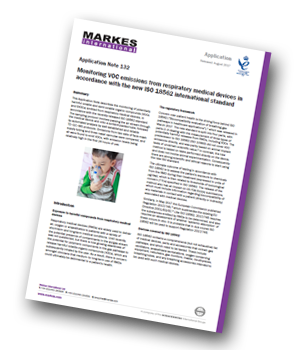Markes International has produced an application note describing the monitoring of potentially
harmful volatile and semi-volatile organic compounds (VOCs and SVOCs) emitted from respiratory medical devices, in accordance with the recently-released ISO 18562 standard.
 Summary
Summary
The sampling protocol involves passing the air stream through the medical device and onto a sorbent-packed tube, followed by automated analysis by well-established and reliable TD–GC–MS protocols. Emissions from two sets of face-mask supply tubing and three nasal cannulas were compared, and all were found to emit VOCs, with emission levels being relatively high in the first 24 hours of use.
Introduction
Exposure to harmful compounds from respiratory medical devices (RMDs) are widely used to deliver air, oxygen or anaesthetics to patients with a variety of short-term and long-term medical conditions. Until recently, the potential presence of contaminants in the air/gas stream was not questioned, but there is now growing awareness of the potential for polymeric components in the gas pathways to release harmful volatile organic compounds (VOCs), which are subsequently inhaled by the user. As a result, there is concern amongst clinicians that medium- to long-term use of RMDs could ultimately be detrimental to a patient’s health.
The regulatory framework
Concern over patient health is the driving force behind ISO 18562 (“Biocompatibility evaluation of breathing gas pathways in healthcare applications”),1 which was released in March 2017. The new standard is split into four parts, with parts 2–4 dealing with the measurement of three types of potentially harmful releases from RMDs, including VOCs.
Devices covered by ISO 18562
ISO 18562 contains a comprehensive (but not exhaustive) list of medical devices, parts and accessories that contain gas pathways, and which need to be tested. These include ventilators, anaesthesia workstations, oxygen-conserving equipment, nebulisers, gas monitors, masks, mouthpieces, breathing tubes, and any breathing accessories intended to be used with such medical devices.
Results
The results obtained on the samples tested show that some of the respiratory medical devices available on the market today emit a broad range of VOCs and SVOCs. Our results indicate that 2-ethylhexan-1-ol and cyclohexanone are the most abundant components in all the samples, but also that many less abundant compounds are present. In addition, a broad oil/hydrocarbon band of unknown origin was also observed. In the context of earlier work we have carried out into emissions from polymeric materials, such emission levels indicate potential issues with manufacturing and/or packaging quality. The use of low flow rates, and the fact that the products were sampled immediately after being removed from the packaging, means that these results represent a ‘worst-case scenario’ for VOC emissions, but nevertheless one that may be typical of products used for the care of certain patients.
Reference
- ISO 18562: Biocompatibility evaluation of breathing gas pathways in healthcare applications.
Part 1: Evaluation and testing within a risk management process, 2017, www.iso.org/standard/62892.html.
Part 2: Tests for emissions of particulate matter, 2017, www.iso.org/standard/62893.html.
Part 3: Tests for emissions of volatile organic compounds (VOCs), 2017, www.iso.org/standard/62894.html.
Part 4: Tests for leachables in condensate, 2017, www.iso.org/standard/62895.html.




